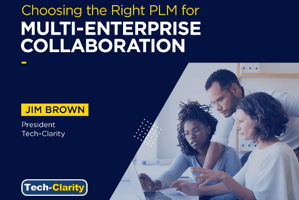 How does the right PLM help improve product development collaboration to create agility, speed, and quality in product innovation? What collaborative capabilities should companies look for when they select a PLM platform?
How does the right PLM help improve product development collaboration to create agility, speed, and quality in product innovation? What collaborative capabilities should companies look for when they select a PLM platform?
Products and product development have become increasingly challenging as manufacturers push the boundaries of product innovation and product development velocity. Manufacturers have to be increasingly agile to react to changing customer needs and market opportunities in the global economy. To support this, today’s product innovation process requires contributions from many roles across the enterprise and the supply chain. Efficient and effective design collaboration across departments, customers, the supply chain, and regulators is more critical than ever.
Please enjoy the summary* below. For the full research, please visit our sponsor PTC (registration required).
For related research, please read some of our previous buyer’s guides, ‘How to’ Choose the Right PDM System, Engineering Buyer’s Guide for Multi-Discipline Systems, or PLM for the Medical Device Digital Thread.
Table of Contents
- Introducing the Buyer’s Guide
- The Collaboration Imperative
- What to Look for: Digital Thread
- What to Look for: Design for X
- What to Look for: Concurrent Engineering
- What to Look for: Partner Collaboration
- Considerations by Role
- Special Considerations
- Implementation and Adoption
- Vendor Considerations
- Conclusions and Next Steps
- Acknowledgments
Introducing the Buyer’s Guide
Structure of the Guide
This buyer’s guide analyzes the strategic necessity of effective multi-enterprise collaboration and shares the criteria companies should consider when choosing a supporting PLM solution. The guide begins with functional requirements needed to streamline collaboration and create digital continuity across the product lifecycle.
The guide looks at collaboration capabilities along four critical categories:
- Supporting the digital thread
- Allowing “design for x”
- Enabling concurrent engineering
- Ensuring secure partner collaboration
The guide covers each of these needs and then goes beyond functional considerations to identify special considerations, vendor requirements, and important factors to ensuring successful implementation and adoption.

Conclusions and Next Steps
Effective Multi-Enterprise Collaboration is Mandatory
Better multi-enterprise collaboration streamlines and improves product innovation processes to get the right products to market, the right way, at the right time. It helps companies get products to market faster and avoid costly, time-consuming errors. Beyond that, collaboration allows manufacturers to embrace product and product development complexity to push the boundaries of product innovation, product development speed, and agility. To operate effectively in this complex environment, manufacturers must collaborate effectively across departments, customers, the supply chain, and regulators.
PLM Serves as the Backbone for Multi-Enterprise Collaboration
PLM is the backbone for multi-enterprise collaboration. Companies must choose a PLM platform that can serve as the foundation to improve product development collaboration to create agility, speed, and quality in product innovation.
To do this, they must select a PLM system that allows them to:
- Support the digital thread
- Allow “design for x”
- Enable concurrent engineering
- Ensure secure partner collaboration
Go Beyond Product Requirements
As with any software selection, recognize that product capabilities are important but only one part of the criteria. Manufacturers must keep in mind factors related to implementation, adoption, security, integration, and vendor support to make sure they get full value from their chosen solution.
*This summary is an abbreviated version of the research and does not contain the full content. For the full research, please visit our PTC (registration required).
If you have difficulty obtaining a copy of the report, please contact us.

